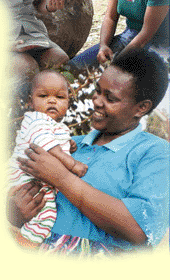
PRIME II increased the quality and use of family planning and reproductive health (FP/RH) services by integrating consumer perspectives and fostering consumer-provider partnerships. Approaches included:
- Consumer/client feedback mechanisms
- Adolescent-friendly services
- Community outreach, advocacy and mobilization.
Key Results
-
Uganda: Responding to high rates of unintended pregnancy and sexually transmitted infections and very low use of FP/RH services, PRIME II worked with adolescents, community leaders and primary providers to design and establish an adolescent-friendly services pilot project in Jinja district. Improved provider knowledge, practices and approaches (for example, privacy, adolescent-only hours and entrances, recreational/educational activities) encouraged adolescent attendance at RH facilities. As a result, the proportion of adolescents among clients seeking outpatient services at the pilot facilities more than doubled, and sexually active adolescents reported higher use of FP methods in the intervention area than in a comparison area (71% vs. 50%) four months after the intervention. The pilot was expanded nationally through the DISH II initiative.
-
Rwanda: Building on the existing health care financing system of community-based prepayment schemes (mutuelles), PRIME II worked to increase accessibility and use of FP/RH services in five districts. Enlisting community health staff (including social workers) and responding to consumer needs, activities increased mutuelle membership and use of services. According to a PRIME II evaluation, a mutuelle member is five times more likely to seek modern health care when sick than a non-member (1.6 vs. 0.27 visits per year). Since 2000, the number of mutuelles increased from 54 to 90 in the five districts, serving more than 325,000 members.
-
Dominican Republic: PRIME II assisted ADOPLAFAM, a local family planning organization, to expand and improve services through a client-centered approach at a clinic serving neighborhoods on the outskirts of Santo Domingo. Introducing mechanisms to collect consumer input led to changes in service delivery (including added gynecological and vaccination services and improved privacy), enhanced client satisfaction with services (from 73% to 88%), and a more than 100% increase in use of services over a 12-month period.
-
El Salvador: Incorporating input from adolescent consumers, PRIME II’s technical assistance at three pilot hospitals between 1999 and 2001 helped to change provider approaches (for example, personalizing care, reducing judgmental attitudes), increase prenatal visits (from 54% to 67% among postpartum adolescent women interviewed) and enhance client satisfaction.
|











